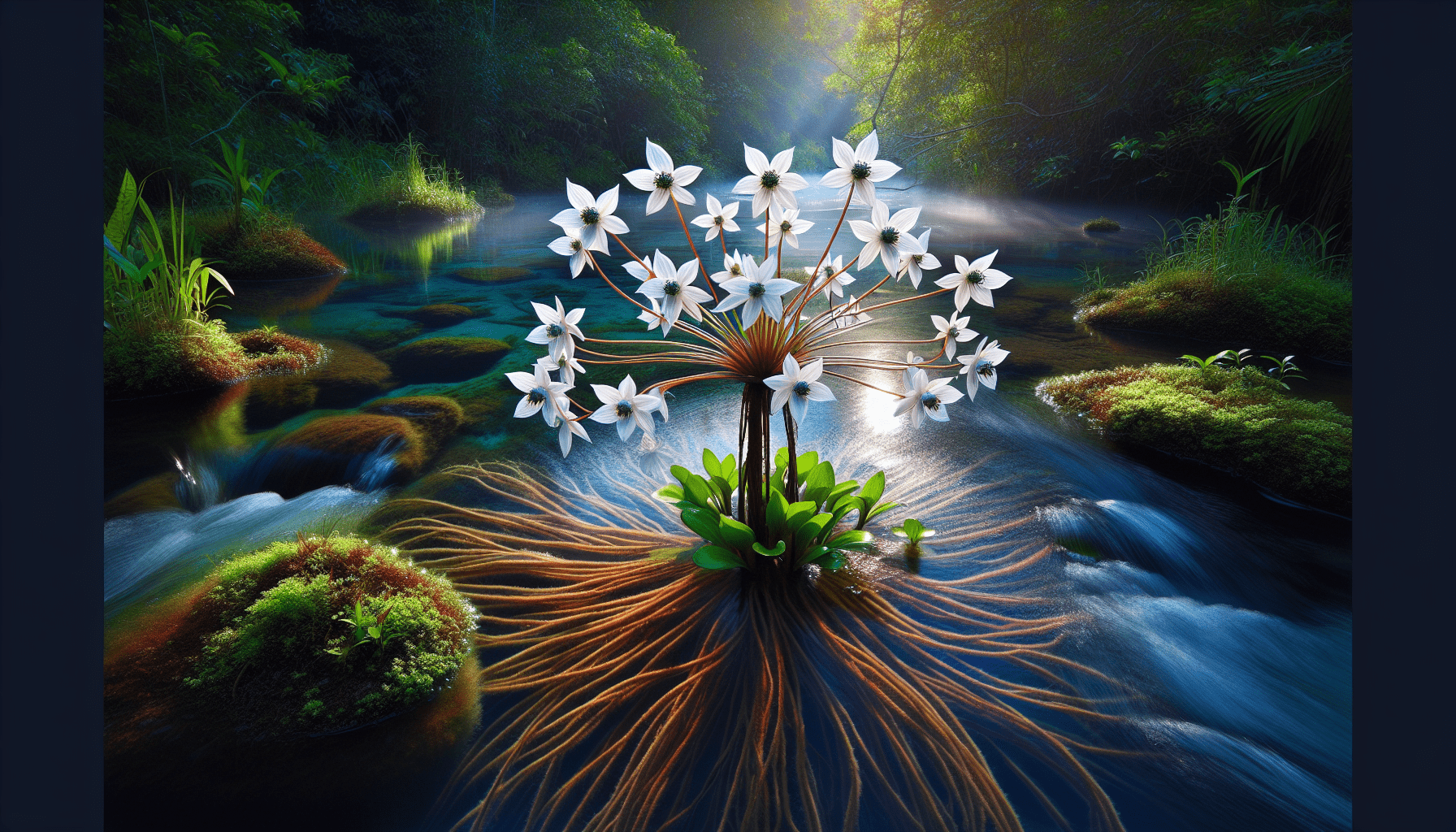In this article, you will develop a thorough understanding of the aquatic weed, Damasonium Alisma. This species, often overlooked in scientific literature, holds significant implications for ecosystem stability and biodiversity health. As you journey through this textual landscape, you will unveil the ecological roles, biological characteristics, and potential impacts of this plant species within aquatic environments. Be prepared to broaden your knowledge about this fascinating yet largely underexplored subject matter.

Identification of Damasonium Alisma
When identifying any plant species, it’s critical to consider the physical characteristics, habitat preferences, and distinctive features.
Physical attributes
Damasonium alisma, also known as the Starfruit, is an aquatic plant species recognized by its distinctive physical attributes. The plant typically measures 30 to 50 centimeters in height, with slender branchless stems emerging from a rosette of basal leaves. The leaves are long (up to 40 cm), linear, and taper to a point. The flowers are small, white and bloom in a whorl formation around the stem.
Habitat Preferences
As an aquatic plant, Damasonium alisma naturally prefers habitats with moist and wet conditions, such as ponds, marshes, canals, and slow-moving streams. It is most commonly found in shallow water or wet mud. The species can survive a wide range of pH levels, from slightly acidic to alkaline waters. It typically thrives in temperate climates.
Distinctive Features
The distinctive feature of Damasonium alisma is its unique fruit, which makes the plant easily identifiable. After pollination, the small white flowers turn into star-shaped fruits, hence the common name Starfruit. The star-shaped fruit is a unique feature not found in most aquatic plants, making it easier to spot among other species.
Taxonomical Classification
To better understand Damasonium alisma, one must explore its taxonomical classification, which depicts its position in the biological hierarchy and offers insight into its evolutionary lineage.
Kingdom
Firstly, Damasonium alisma belongs to the Kingdom Plantae, which comprises all green plants.
Division
Within Plantae, Damasonium alisma falls under the Division Tracheophyta (also known as vascular plants). These plants are categorized by their specialized tissues, xylem and phloem, which aid in vertical nutrient and water transportation.
Class
The Class of Damasonium alisma is Magnoliopsida, more commonly known as dicotyledons or dicots. This class is synonymous with flowering plants that typically produce seeds with two embryonic leaves or cotyledons.
Order
The Order for Damasonium alisma is Alismatales, a group largely made up of aquatic plants.
Family
Falling within the Family Alismataceae, also known as the water-plantain family, Damasonium alisma shares similarities with other aquatic and semi-aquatic plants.
Genus
The species belongs to the Genus Damasonium, which consists of a handful of species commonly referred to as Starfruit.
Species
Finally, the Species is identified as Alisma, making the full scientific name Damasonium alisma.
History and Distribution of Damasonium Alisma
The history and distribution of Damasonium alisma tell us much about its origins and currents whereabouts.
Origins
The origins of Damasonium alisma are traced back to Central and Eastern Europe, where it is believed to have first grown.
Places of Popularity
Over time, the species has found popularity in other parts of the world including America, Asia, and North-West Africa due to its use in aquatic gardening and its medicinal properties.
Current Distribution
Currently, Damasonium alisma is found throughout the globe, though the natural distribution is primarily across parts of Europe, Asia, and Africa.

Propagation and Growth of Damasonium Alisma
Understanding the propagation and growth cycles of Damasonium alisma adds depth to our knowledge about this plant’s behavior and preferences.
Reproduction Cycle
Damasonium alisma primarily reproduces through seeds. After the white flowers get pollinated, star-shaped fruits develop which scatter countless seeds. These seeds are transported by water currents, allowing them to colonize new areas.
Growth Conditions
This plant species thrives in saturated soils or shallow standing water. It requires plenty of light and prefers water with a wide range of pH conditions, from slightly acidic to slightly alkaline. Damasonium alisma also demonstrates winter-hardiness, surviving all but the most severe frosty conditions.
Ecological Roles of Damasonium Alisma
Every species plays some role in the ecosystem. Damasonium alisma is peculiar in the sense that it has ecological functions revolving around biodiversity promotion and habitat creation.
Biodiversity Promotion
Damasonium alisma exhibits certain properties that actually promote biodiversity. Its roots provide shelter for water insects and other small aquatic animals, thereby contributing to overall ecosystem health.
Habitat Creation
The underwater parts of the plant provide an excellent microhabitat for young waterfowl and other species, contributing substantially to biodiversity and habitat creation.
Benefits of Damasonium Alisma
Damasonium alisma offers a multitude of benefits, which can be categorized into three primary sectors: ecological, medicinal, and aesthetic.
Ecological
As previously stated, Damasonium alisma plays significant roles in promoting biodiversity and creating habitats. Moreover, it contributes to the nutrient cycle and assists in trapping and holding sediments, reducing shoreline erosion.
Medicinal
Traditionally, Damasonium alisma has been used for its medicinal properties like treating digestive disorders, rheumatism, and skin ailments. However, modern scientific studies to substantiate these properties are yet to be thoroughly conducted.
Aesthetic
Aesthetically, Damasonium alisma’s white, star-shaped flowers and the unusual starfruit forming after pollination rends it a popular choice for water gardening and landscaping.
Challenges posed by Damasonium Alisma
Like many organisms, Damasonium alisma poses certain challenges to ecosystems and humans.
Invasive Nature
Despite the benefits associated with Damasonium alisma, it has a tendency to colonize new areas rapidly. If left unchecked, it can potentially choke water bodies, blocking light penetration, and disturbing the native ecosystem.
Threat to Aquatic Ecosystems
High infestation levels of Damasonium alisma can disrupt the balance of aquatic ecosystems. It competes with native species for resources and if its growth rate surpasses that of native species, a significant loss of biodiversity could ensue.
Management and Control of Damasonium Alisma
Appropriate management and control measures can prevent the invasive nature of Damasonium alisma.
Physical removal methods
Manual removal can be effective for light infestations. This method usually involves hand-pulling or raking the plants and removing them from the water body. However, this method is labor-intensive and not suitable for extensive infestations.
Chemical control methods
For larger infestations, herbicides can be used. However, it’s important to seek professional advice for the correct type and amount of herbicide to minimize ecological damage.
Biological control methods
Using biological agents, freshwater weevils for instance, can also be beneficial in controlling the spread of Damasonium alisma. But, this could take a significant amount of time to yield noticeable results and overall success varies.
Conservation Status of Damasonium Alisma
The conservation status of Damasonium alisma varies according to its geographical distribution.
Current Status
Currently, Damasonium alisma has an overall “Least Concern” status on the IUCN red list, as it is quite widespread.
Endangered Areas
However, in certain areas such as the UK, Damasonium alisma is considered “Near Threatened” due to habitat loss and degradation, pushing conservationists to protect its local populations.
Conservation Efforts
A range of measures are being taken to conserve Damasonium alisma, such as habitat restoration, restrictions on draining wetlands, and raising public awareness about its ecological importance.
Future Prospects of Damasonium Alisma
Predicting the future of Damasonium alisma offers insight into upcoming research opportunities, potential uses, and future threats.
Research Opportunities
More scientific research needs to be undertaken to investigate the medicinal properties of Damasonium alisma, which would foster its use in the pharmaceutical industry. Additionally, its invasive nature provides an opportunity for research in ecological control and management strategies.
Potential Uses
Aside from its current applications, Damasonium alisma has potential uses in environmental remediation due to its ability to trap sediments and contribute to nutrient cycles. Future Threats
Lastly, considering its invasive nature, climate change, alterations to its natural habitats, and uncontrolled spread could all become potential threats to native ecosystems and its overall survival, emphasizing the need for cautious management and protective measures.